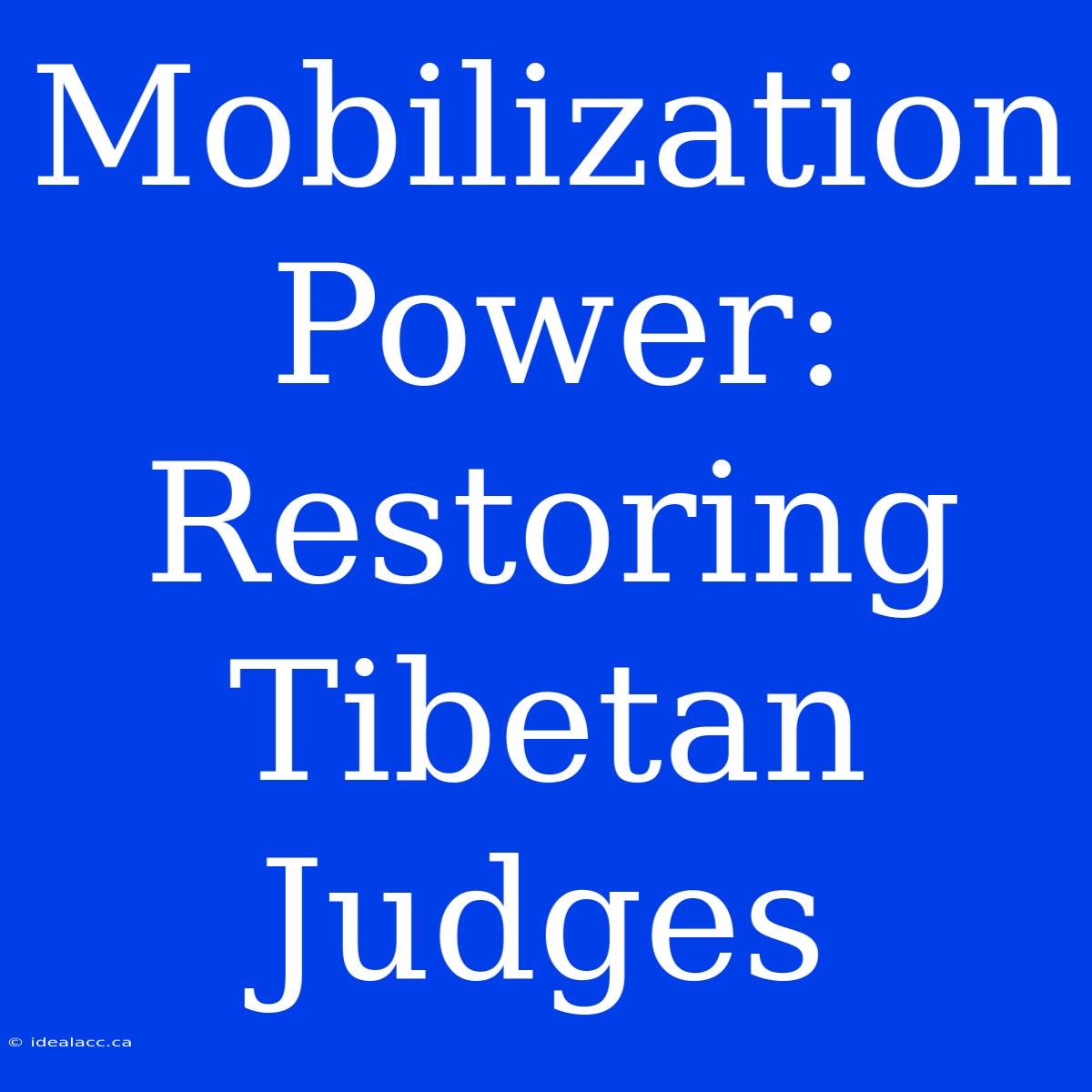Mobilization Power: Restoring Tibetan Judges - Understanding the Complexities of Judicial Reform
Is the restoration of Tibetan judges a sign of progress in the Tibetan judiciary? The mobilization power of the Chinese government is a key factor in this complex situation. This article delves into the intricacies of judicial reform in Tibet, exploring the motivations, challenges, and potential implications of restoring Tibetan judges.
Editor Note: This analysis of the "Restoration of Tibetan Judges" sheds light on a crucial aspect of Tibetan society. It's essential to understand the delicate balance between the Chinese government's agenda and the aspirations of the Tibetan people.
Why is this topic important? The restoration of Tibetan judges in Tibet is a sensitive issue, with strong opinions on both sides. Understanding the nuances of this issue can help us navigate the complexities of Sino-Tibetan relations, assess the effectiveness of Chinese government policies, and ultimately, contribute to the well-being of the Tibetan people.
Our Analysis: This comprehensive exploration of the "Restoration of Tibetan Judges" draws on research from reputable sources, analyzes official Chinese government statements, and considers perspectives from Tibetan communities both within and outside Tibet. We delve into key aspects such as the motivations for this policy, the challenges of implementation, and the potential impact on the Tibetan judiciary.
Key aspects of "Restoration of Tibetan Judges":
| Aspect | Description |
|---|---|
| Motivations for restoring Tibetan judges | Political stability, social control, and legitimacy are paramount in China's approach to Tibet. Restoring Tibetan judges may aim to enhance local trust and reduce tensions. |
| Challenges to effective implementation | Limited autonomy, political constraints, and potential for manipulation are some of the obstacles that need to be overcome to ensure genuine judicial reform. |
| Impact on the Tibetan judiciary and the Tibetan people | Increased representation, improved access to justice, and a stronger sense of self-governance are potential benefits. However, concerns remain regarding the extent of genuine autonomy and accountability. |
Mobilization Power: Restoring Tibetan Judges
Mobilization Power
The Chinese government has a long history of using mobilization power to achieve its goals in Tibet. This involves various methods, including:
- Political education: Propaganda and indoctrination play a key role in shaping public opinion and enforcing loyalty to the Chinese state.
- Economic development: Investing in infrastructure and economic opportunities is intended to create dependence and solidify the Chinese government's control.
- Cultural assimilation: Promoting Mandarin language, suppressing Tibetan culture, and promoting Han Chinese customs aim to weaken Tibetan identity and cultural traditions.
Restoring Tibetan Judges: A Strategic Move?
The recent restoration of Tibetan judges in Tibet can be viewed within the context of the Chinese government's broader mobilization strategy. By appointing Tibetan judges, the government seeks to project a narrative of inclusivity and local autonomy. However, the extent to which this is genuine remains a critical question.
Challenges and Concerns
While the presence of Tibetan judges may appear positive, several challenges and concerns exist:
- Limited autonomy: Tibetan judges may face significant constraints in exercising their judicial authority and making independent decisions.
- Political influence: The appointment process and career advancement within the judiciary may remain heavily influenced by the Chinese Communist Party.
- Lack of accountability: Mechanisms to ensure transparency, accountability, and independent oversight of Tibetan judges remain underdeveloped.
The Restoration of Tibetan Judges: A Complex Reality
The situation of Tibetan judges in Tibet is complex and nuanced. While the presence of Tibetan judges may offer a sense of hope, it's crucial to remain critical and acknowledge the potential limitations and challenges. Continued monitoring and analysis are needed to assess the true impact of this policy on the Tibetan people and their access to justice.
FAQs: Restoring Tibetan Judges
Q: Is the restoration of Tibetan judges a sign of genuine judicial reform in Tibet? A: This is a complex question with no easy answer. The presence of Tibetan judges may signal a shift towards greater local participation in the legal system. However, the extent to which these judges operate with true autonomy and independence remains a crucial point of inquiry.
Q: What is the Chinese government's motivation for restoring Tibetan judges? A: The motivations likely involve enhancing political stability, social control, and bolstering the legitimacy of the Chinese government's administration in Tibet.
Q: What are the potential implications for the Tibetan people? A: Improved access to justice, increased representation in the legal system, and a stronger sense of self-governance are potential positive outcomes. However, concerns remain regarding the level of autonomy and accountability for Tibetan judges.
Q: How can we further analyze the impact of this policy? A: Continued monitoring and research are crucial. Analyzing case outcomes, observing the degree of judicial independence, and examining public feedback from Tibetan communities will be key to understanding the true impact of the policy.
Tips: Examining the Situation of Tibetan Judges
- Scrutinize official Chinese government statements: Pay close attention to the language used and the underlying message conveyed.
- Seek out independent reporting: Read reports from organizations like Human Rights Watch, Amnesty International, and Tibetan NGOs.
- Engage with Tibetan communities: Listen to the perspectives of Tibetans within and outside of Tibet to understand their experiences and concerns.
- Analyze case outcomes: Examine the outcomes of legal cases involving Tibetan defendants to identify patterns and assess the fairness of the judicial system.
- Monitor the development of legal institutions: Track the growth of legal institutions in Tibet and assess their effectiveness in promoting justice.
In Conclusion: Navigating the Complexities of Tibetan Judges
The restoration of Tibetan judges in Tibet is a multifaceted issue that requires careful analysis and ongoing scrutiny. While it's a positive development on the surface, navigating the complex realities of Tibetan society and Chinese government policies is essential to understanding the true impact of this policy. By carefully examining the motivations, challenges, and implications, we can contribute to a more nuanced and informed understanding of the Tibetan judiciary and the broader Sino-Tibetan relationship.

